A weekend trip out to the Pineywoods to see Nana and Papa Don’s new rural property proved to be a birdwatching opportunity extraordinaire, just in time for the Great Backyard Bird Count. Getting up early on Sunday, I sat quietly outside with camera, notepad, and binoculars in hand for thorough observation and counting.
Being out in country, we witnessed numerous sparrows and other birds I just don’t get to see much, if at all, in urban Austin. The White-Throated Sparrows were plentiful — they are easy to distinguish by their — ahem — white throat feathers, as well as the little golden patches between their eyes and bill.
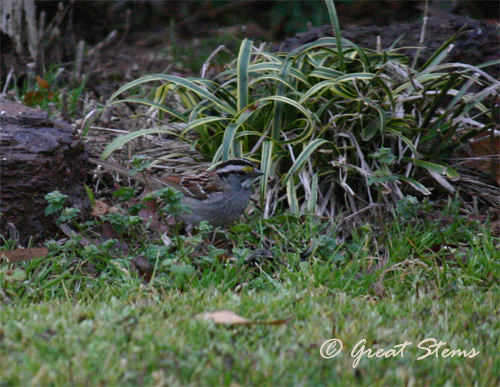
The Cardinals were the brightest of the lot — at least the males were — and they were feisty, chasing each other all around. In their favorite barely-budding tree, they looked like big red fruit.
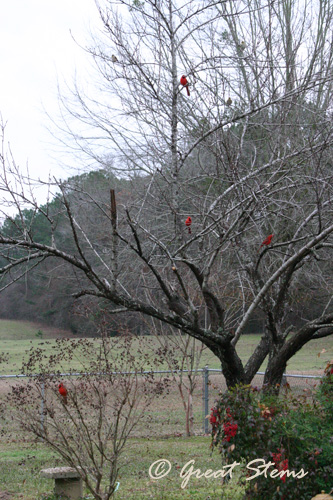
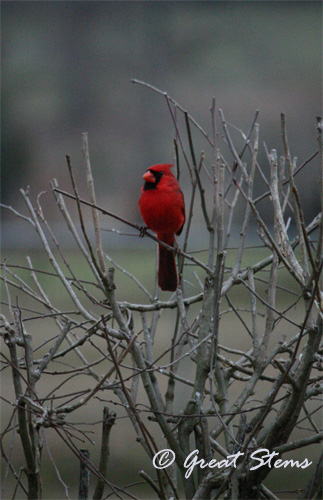 The winners of the tally were without a doubt the American Goldfinches. We counted 36 in the backyard alone, and they feasted from feeders and foraged in the grass. They are still in their winter feathers, but some of them had very noticeable yellow showing through — summer coloration on its way.
The winners of the tally were without a doubt the American Goldfinches. We counted 36 in the backyard alone, and they feasted from feeders and foraged in the grass. They are still in their winter feathers, but some of them had very noticeable yellow showing through — summer coloration on its way.
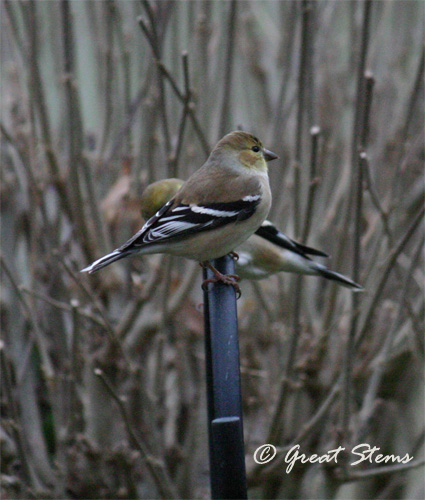
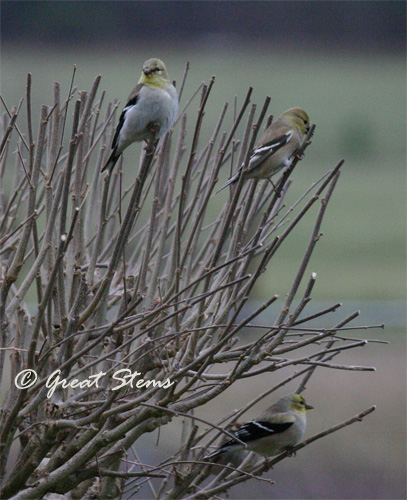
The Goldfinches had no problem sharing the best food spots with other birds, like Chipping Sparrows and Cardinals.
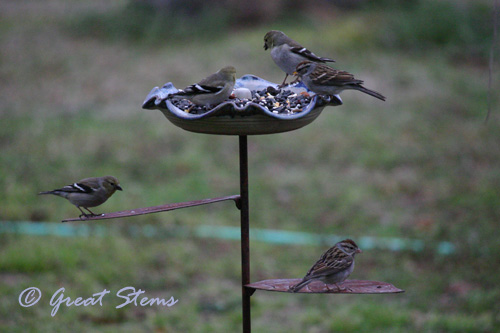
For sheer beauty, the Eastern Bluebirds had my vote. I’m biased because I so rarely see blue-feathered birds, except for Blue Jays. The female Bluebird below is much paler than her mate, who sported vibrant blue and tan feathers but decided to not be accessible for a decent picture.
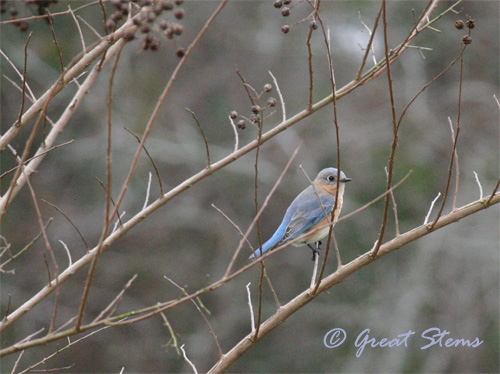 There were two Red-bellied Woodpeckers visiting at the feeders, and two Northern Flickers foraged in the field at the back of the property. I didn’t realize Flickers foraged on the ground, but apparently they like ants. In contrast, the Red-bellied Woodpeckers would grab seeds from the feeder and fly up to nearby trees to break the shells open. When they weren’t eating, the Woodpeckers called loudly from the trees or rat-ta-tat-tatted on the telephone pole nearby. It can be hard sometimes to tell that they have red belly feathers — the picture below hints at the belly blush.
There were two Red-bellied Woodpeckers visiting at the feeders, and two Northern Flickers foraged in the field at the back of the property. I didn’t realize Flickers foraged on the ground, but apparently they like ants. In contrast, the Red-bellied Woodpeckers would grab seeds from the feeder and fly up to nearby trees to break the shells open. When they weren’t eating, the Woodpeckers called loudly from the trees or rat-ta-tat-tatted on the telephone pole nearby. It can be hard sometimes to tell that they have red belly feathers — the picture below hints at the belly blush.
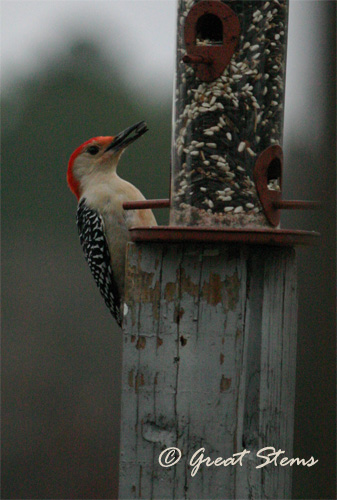
The Tufted Titmice seemed more skittish than Austin’s Black-Crested Titmice, but perhaps that’s simply because the ones at my house are very settled in their habitat. “My” birds yell at each other, at Screech Owl neighbors, at suspicious cats, at other songbirds, and seemingly at trees and leaves and anything else that they are perturbed by. Their country cousins, on the other hand, snuck in by way of brush for cover, stole a quick seed, then zipped back out just as fast without even a chirp.
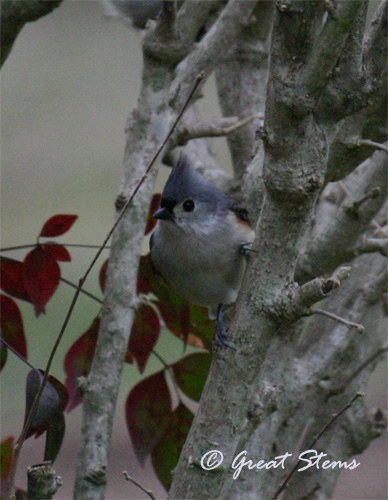
Our toughest challenge to ID was the large sparrow-looking bird that turned out to be not a sparrow at all. She’s a Red-winged Blackbird, looking nothing like the appropriately colored males for which the species is named. I couldn’t ID her until I got home to the computer.
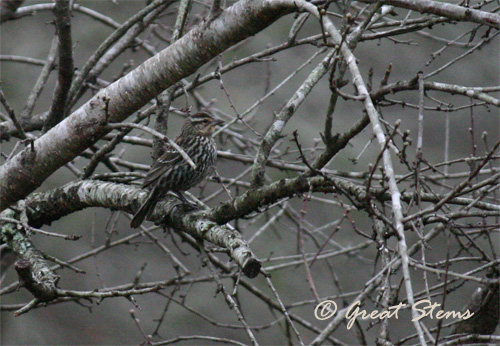 In all, we identified 18 species, but there were definitely more out there — we just couldn’t get close enough to either count or ID them. Here’s the complete list of what we found out there in the Pineywoods:
In all, we identified 18 species, but there were definitely more out there — we just couldn’t get close enough to either count or ID them. Here’s the complete list of what we found out there in the Pineywoods:
-
American Goldfinch
-
Northern Cardinal
-
Eastern Bluebird
-
Red-winged Blackbird
-
White-Throated Sparrow
-
Chipping Sparrow
-
Black Vulture
-
American Crow
-
Eastern Purple Martin
-
Northern Mockingbird
-
Red-bellied Woodpecker
-
Northern Flicker
-
Tufted Titmouse
-
Carolina Chickadee
-
Blue Jay
-
Ruby-crowned Kinglet
-
Dark-eyed Junco
-
Old World: European Starling
The evening before, I rescued a toad from the new veggie garden — I really didn’t want it to get caught in a tiller by gardening madman Papa Don. I’m not sure whether it is a Woodhouse’s Toad or the subspecies East Texas Toad — there wasn’t clear distinguishing info available. But it certainly was a handsome and cooperative toad, all short and squat and warty. We put it out in the field with all the mole tunnels that drive Papa Don crazy.
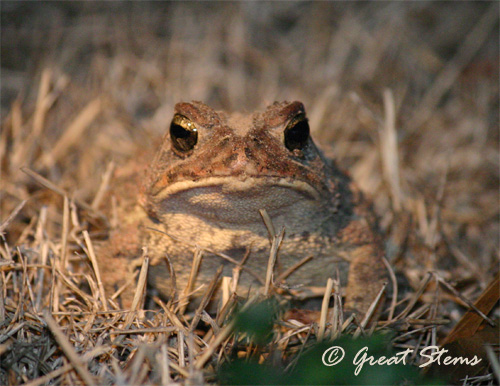
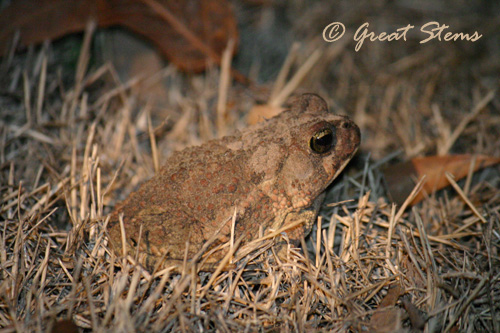
Back at home, I’ve been doing my own Austin bird counts. I’ve decided I need to rearrange everything in my yard to make bird-watching more convenient. Yes, that includes plants!
lovely photos, however it seems like the birds are all conveying some melanchollic stance to me! I don’t know it might just be me? ..and i like the toad looking caught in the act, mesmerized!
Those little red birds on the tree look like red flowers. Beautiful. I like the toad too. I always enjoy your animal photos.
Lovely images of your birds Meredith. A little bird told me to stop in and I am glad I did.
A cardinal tree!
I wish we had Cardinals here in the Pacific Northwest – such lovely colour! The Titmice look cute too!!
Great photos! Wow, you were busy! It’s fun to see the goldfinches with their summer color starting!
I would have had a hard time calling the female blackbird also. Great list for a day’s outing.
Beatiful birds! Meredith, I’ve awarded you the Stylish Blogger Award – you can visit Garden Sense to learn more, if you’d like. If you’d rather not participate, no problem. But I hope more people will discover your great blog!
How delightful! I love to watch birds. I definitely think the Cardinals are a bright spot for sore eyes–me! I’m just seeing white these days. Getting 3 inches of snow today! I loved the frog at the end. What a cutie. We had one at our home that we had caught in the wild, but I felt so bad for it, that we took it back out in the wild by a pond and let it go. BTW, if you are interested, I relaunched my gardening blog at http://www.GardenStems.com. I hope to see you there. Have a wonderful day wildlife hunting!
Meredith, I always enjoy dropping by your blog. Reminds me again of seeing 12 species at one feeder in a 10 minute span during breakfast at a NC B&B last fall. The Eastern bluebird and Tufted Titmouse are at the top of my list of favorites, but they are all beautiful. Thank you!
Great photos!!! Lovely birds !!!